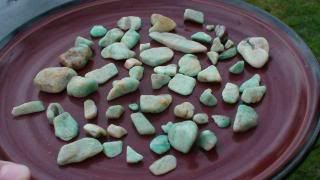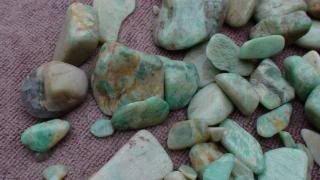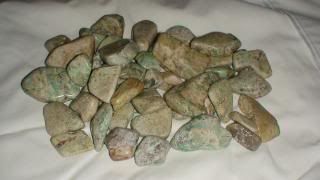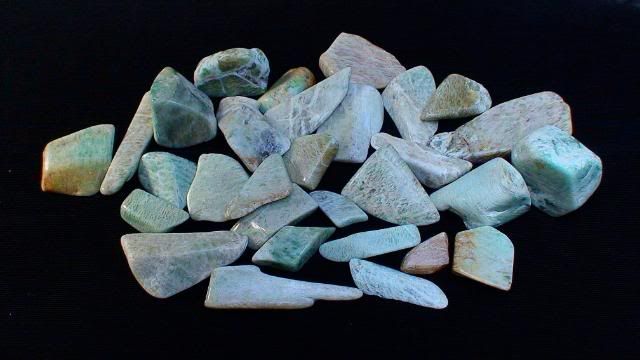|
|
Post by Noosh9057 on Aug 30, 2009 14:27:40 GMT -5
Well I also ordered 5 pounds of Amazonite from the Rock shed. What do you all know about this rock. Well I think it is very hard so normal tumbling proses would be right for this rock. I think this is right can someone tell me if I am right about tumbling Amazonite.
Thanks Roger
|
|
|
|
Post by moondragon on Aug 30, 2009 14:35:26 GMT -5
A couple of weeks ago when our rockhound club went to the GeoScience Museum there was some Amazonite there. I had a pocketfull of moonstones that Jo had sent me to show off. And the Professor said it was Amazonite even though my moonstone is more a minty green and the one he showed us was more a turquoise color. But the veins/texture/lines in the stone looked the same. Cant wait to see what you create:) www.gemselect.com/gem-info/amazonite/amazonite-info.php |
|
|
|
Post by NatureNut on Aug 30, 2009 15:20:06 GMT -5
Yep, Sara, the moonstone that I sent you is colored with a minty green microcline, which is amazonite. The difference between is tricky but I'll try to explain my understanding, through my experience with it, visiting our local museum, and discussions with other collectors in my area...
(not that I'm sure I'm right, because I am always learning)
Where the microcline has schiller and exists in oligoclase or orthoclase, it is considered moonstone colored with microcline. When the microcline has no schiller, then it is considered amazonite. This has been very confusing, because I have seen samples called amazonite that had schiller, and visa versa. Which is entirely confusing, because the nature of moonstone is such that it needs to be cut on a certain plane in order to get the schiller. So, if the stones that can exist in both categores are cut in a direction against the schiller, are they then amazonite? See what I mean. But, I do believe (and this also comes from studying samples in our local museum), and have witnessed, that some minty green microcline does exist that has no schiller, and is therefore true amazonite.
Roger, I'd have to see your rocks to tell you how hard they look and where they fall into the mix, however, to answer your question (and I've tumbled this stuff extensively)... yes, they are a tricky tumble.
The hardness can vary greatly from a very soft almost calcite consistency to a harder almost quartzlike quality. I have had some success rounding in a rotary and then processing in a vibe from 220 on. It does go fast, so check it early and be prepared to do shorter runs with it. The white material, depending on how hard it is (again, it can vary) can undercut, so be prepared to re-break or shape with your saw. In fact, I recommend starting out with your rough cut by your saw, I've had greater success that way. Also, if there are any quartz crystals mixed in, which does occur, it can undercut in those areas. I have had some success cutting them flat, but also left them as is and just cleaned them very well. (I've also had the idea of filling the quartz areas with superglue to minimize this)
As far as running in your tumbler, I have had some success with adding a few chips from a bar of Dove soap. It aids in sliding and the bubbles act as cushion. It does slow down the action of the grit a little, but they seem to come out of battle with less scarring. Do not run with anything harder than a Mohs 6, and use PLENTY of cushion. Also, I started burnishing with a few squirts of liquid dish soap, borax just seemed to be too harsh for it. Mine do well using Rock Shed AO polish.
I do two or three rounds of 220 (no 60/90, no rotary, just the vibe) for 2 days each. Then one or two rounds of 500 grit prepolish, for 2 days each. Then, a day or two in 1000 grit prepolish. Then 3 or 4 days in AO.
Like I said, I've been lucky enough to have alot of this to play with and this is what I've stumbled onto, although I am still observing, learning and adjusting.
Hope this helps! Jo
|
|
|
|
Post by Noosh9057 on Aug 30, 2009 15:41:52 GMT -5
Yep, Sara, the moonstone that I sent you is colored with a minty green microcline, which is amazonite. The difference between is tricky but I'll try to explain my understanding, through my experience with it, visiting our local museum, and discussions with other collectors in my area... (not that I'm sure I'm right, because I am always learning) Where the microcline has schiller and exists in oligoclase or orthoclase, it is considered moonstone colored with microcline. When the microcline has no schiller, then it is considered amazonite. This has been very confusing, because I have seen samples called amazonite that had schiller, and visa versa. Which is entirely confusing, because the nature of moonstone is such that it needs to be cut on a certain plane in order to get the schiller. So, if the stones that can exist in both categores are cut in a direction against the schiller, are they then amazonite? See what I mean. But, I do believe (and this also comes from studying samples in our local museum), and have witnessed, that some minty green microcline does exist that has no schiller, and is therefore true amazonite. Roger, I'd have to see your rocks to tell you how hard they look and where they fall into the mix, however, to answer your question (and I've tumbled this stuff extensively)... yes, they are a tricky tumble. The hardness can vary greatly from a very soft almost calcite consistency to a harder almost quartzlike quality. I have had some success rounding in a rotary and then processing in a vibe from 220 on. It does go fast, so check it early and be prepared to do shorter runs with it. The white material, depending on how hard it is (again, it can vary) can undercut, so be prepared to re-break or shape with your saw. In fact, I recommend starting out with your rough cut by your saw, I've had greater success that way. Also, if there are any quartz crystals mixed in, which does occur, it can undercut in those areas. I have had some success cutting them flat, but also left them as is and just cleaned them very well. (I've also had the idea of filling the quartz areas with superglue to minimize this) As far as running in your tumbler, I have had some success with adding a few chips from a bar of Dove soap. It aids in sliding and the bubbles act as cushion. It does slow down the action of the grit a little, but they seem to come out of battle with less scarring. Do not run with anything harder than a Mohs 6, and use PLENTY of cushion. Also, I started burnishing with a few squirts of liquid dish soap, borax just seemed to be too harsh for it. Mine do well using Rock Shed AO polish. I do two or three rounds of 220 (no 60/90, no rotary) for 2 days each. Then one or two rounds of 500 grit prepolish, for 2 days each. Then, a day or two in 1000 grit prepolish. Then 3 or 4 days in AO. Like I said, I've been lucky enough to have alot of this to play with and this is what I've stumbled onto, although I am still observing, learning and adjusting. Hope this helps! Jo Here is a link to the stuff I bought from the Rock Shed. What do you think about it. therockshed.com/crushed/amazonitea.jpgtherockshed.com/crushedrock2.html |
|
|
|
Post by NatureNut on Aug 30, 2009 16:16:33 GMT -5
Yep, very similar to what I have. The rough in the Rock Shed pics have less white stuff than mine, which is good news for you for tumbling, but still has the smoky quartz. I do see the layering and one of them looks to exhibit schiller. You would help yourself out a great deal by rounding all edges with your saw, just a suggestion. Here are some pics of some of my tumbles for your reference (sorry for the crappy pics, but this is when I first started): Out of 60/90 in the rotary:  Out of 220 in the vibe:  Out of 500 prepolish:  Out of AO polish for 5 days:  And these are my last batch using the Dove soap and burnishing with liquid dish soap starting just before polish stage:  I do have a batch in polish right now that I used the Dove soap and liquid dishwashing liquid burnish from the beginning (220 in vibe). Also, when taking pics of this stuff, use super low, diffused lighting... bright light seems to make this stuff just look white and you loose that beautiful pastel color and patterning. I take mine just inside my garage on cloudy days, believe it or not, and get the best results with this stuff. As you can see, my stuff has other colors and minerals mixed in, creating patterns in my rock, so it is a little different. Your Rock Shed Brazillian stuff is very pretty, very pure, you should be pleased with it. I hope this gives you some mental ammunition Noosh.  Jo |
|
|
|
Post by tkrueger3 on Aug 30, 2009 17:31:10 GMT -5
Noosh, here are some examples of some of my Rock Shed amazonite - all 3 of these were tumbled in both rotary and in the vibe, and polished with everything from AO polish to M-5, to Super Cerium, etc. I only finally got a decent shine on them using silicon carbide belts on my expando wheel, and final polishing using a tin oxide polishing lap glued to my 8" polishing wheel.    Tom |
|
|
|
Post by NatureNut on Aug 30, 2009 18:31:49 GMT -5
Yep, I'm seeing schiller in cabs 1 & 3 Tom.
|
|
|
|
Post by tkrueger3 on Aug 30, 2009 20:42:01 GMT -5
Schiller - is that what you're calling the little sparkly bits? The ones I tried my darndest to polish off?  Wow. I can see where I'll have to have my wits about me to work on any moonstone! Tom PS - cab # 2 looks so much different from the other 2, but guess what - they all 3 came from the same slab bag of Rock Shed rough! |
|
|
|
Post by NatureNut on Aug 30, 2009 21:48:22 GMT -5
Cab #2 looks more like Amazonite and the others look more like my moonstone (or Perthite.) That's not surprising. Depending on the arrangement of the rocks, I find them mixed in the same area. The difference is the amount of the presence of oligoclase or orthoclase, which is the moonstone part of it (as my understand goes.)
Noosh, sorry for the hijack. Jo
|
|
|
|
Post by Noosh9057 on Aug 31, 2009 6:18:26 GMT -5
Well thanks so much for all the help. I cant wait to get started.
Roger
|
|
|
|
Post by moondragon on Aug 31, 2009 8:34:22 GMT -5
Yall know I am just a kindergartener in with a bunch of renaissance artists but..
I was reading that you put dip your stones in a good quality sonic jewelry cleaner and it will get rid of some of the stuff in the cracks.
I will withdraw this statement if it is erroneous.
|
|
|
|
Post by Toad on Aug 31, 2009 9:03:10 GMT -5
Probably depends on the stone. Wouldn't want to do that with emerald - not that many tumble that - or anything else that tends to have fractures/cracks.
|
|